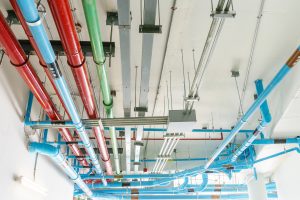‘I only want to know what I need for TCO’: Plumbing Division Signoffs
By Austin Regan, R.A.

In the opening article of this series, we mentioned the four Department of Building (DOB) divisions that must sign off on issuance of a Final Certificate of Occupancy (CO):
- Construction Division
- Plumbing Division
- Elevator Division
- Electrical Division
As previously discussed, Temporary Certificates of Occupancy (TCOs) require temporary signoffs from the first three divisions. (Electrical Division signoff can wait for Final CO.) We have talked about two of the three signoffs needed, Construction Division and Elevator Division.
Now the time has come to talk about the most difficult signoff to receive: Plumbing Division.
Plumbing Division Signoff
When we discussed the criteria for Construction Division signoff, we emphasized the importance of the site’s physical appearance. For the plumbing signoff, how the site looks does not matter. How the paperwork looks—or, more specifically, how the computer says the paperwork looks—is key.
Types of Plumbing Inspections
The DOB requires plumbers and sprinkler contractors to schedule periodic inspections to record the progress of their work.
- All plumbing work requires a roughing inspection, which needs to occur after installation of supply, storm, and sanitary piping but before walls are closed up.
- Gas work also requires inspections, some of which cannot be self-certified.
- Sprinkler and standpipe work does not require roughing inspections, but a hydrostatic test must be performed.
- If a fire pump is part of the sprinkler/standpipe system, that, too, will need to be tested and inspected.
Licensed contractors certify completion of their work by submitting finish inspections.
The Chief’s Review
Requests for TCO Plumbing signoffs are made electronically. When making the request, identify the floors for which you are requesting signoff, as well as the applications related to the job. The initial requests are normally for temporary signoffs, as all wet trade-related applications have to be completely signed off to qualify for a final.
Normally, the Plumbing Division will only grant signoffs for floors that have already received temporary construction signoffs. While the chief will allow signoffs for certain floors, the standpipe system has to be fully inspected and operational for the entire building. Sprinklers must be fully inspected for the floors requested, plus the floors above and below.
The chief begins the review by checking the main application, either an Alterations Type 1 (Alt-1) or New Building application. The Schedule A will tell him what type of building it is and how many floors it has. Schedule A also describes the uses per floor. A boiler room listed in the cellar will prompt a search for a separate boiler filing, as well as the status of the boiler signoff. If the boiler filing indicates a gas-fired boiler, he will check the Schedule B to verify that heat is a specified gas usage and that the plumber has received authorization to turn gas on for heat. If he sees a restaurant listed on the Schedule A, he will look for a separate ansul filing and signoff for the hood fire suppression system. After the chief understands the uses in the building, he reviews the inspection records to ensure that all inspections have been recorded.
DOB NOW: Inspections
The licensed contractor’s inspections are all requested and results are recorded in DOB NOW: Inspections. The request for inspections and the results must be submitted for each floor individually. Larger buildings may have inspections scheduled for partial floors. In high-rise buildings, a common exclusion on the floors may be apartments where the hoist was located.
Gas is always a critical concern. In an apartment building, for instance, the chief will not issue a Temporary CO signoff unless gas has been authorized for heat and cooking. Gas authorization will not be granted unless the floors using gas have passed their related sprinkler inspections. In the case of the apartment building, where signoff is only being requested for certain floors, the chief will require an affidavit attesting that lockout devices have been placed on all gas outlets that do not have fixtures connected to them.
DOB NOW: Inspections has a helpful feature that lists all completed inspections by floor, which makes it possible to anticipate issues before making the official request for signoff. One missing inspection will cause the signoff request to be denied. When inspections are being performed for only parts of a building, the plumber or fire suppression contractor must clearly identify in the comments section which parts of the building are being inspected.
A Helpful Tip
In the case of alterations (as opposed to new buildings), unrelated open applications from prior years can derail the CO plumbing signoff request. Trying to close out these long-forgotten applications is often a monumental and expensive task. It is always in the building owner’s best interest to insist that all DOB applications, regardless of size or complexity, be signed off as soon as the construction work has been completed.
The CO Plumbing Division signoff request is definitely the most complex of the three division signoffs needed for TCO. Upon securing this signoff, only a few hurdles remain to obtaining the TCO. Next month we will address those challenges.

